What Are Shelled Beans?
Shelled beans refer to legumes that have been removed from their pods before cooking or consumption. Unlike green beans or snap beans where you eat the entire pod, shelled beans require you to extract the tender seeds from inside their protective casings. These versatile legumes come in many varieties including lima beans, fava beans, cranberry beans, butter beans, and many more.
Fresh shelled beans appear in markets during late summer and early fall, offering a seasonal delicacy that bridges the gap between tender spring vegetables and heartier winter fare. Their texture when fresh is remarkably creamy yet firm, providing a completely different eating experience than their dried counterparts.
You’ll find shelled beans in three main forms at grocery stores and farmers markets:
- Fresh: Still in their pods, requiring manual shelling
- Pre-shelled fresh: Already removed from pods but not dried
- Dried: Fully matured and dehydrated for long-term storage
The nutritional profile of shelled beans makes them worth seeking out. They deliver exceptional plant-based protein, dietary fiber, complex carbohydrates, and essential minerals like iron, magnesium, and potassium. One cup of cooked shelled beans typically provides 12-15 grams of protein and 9-13 grams of fiber, making them perfect for balanced meals.
Many home cooks overlook fresh shelled beans even though their superior flavor and shorter cooking time compared to dried varieties. When Liam first discovered cranberry beans at his local farmers market, he was amazed by how quickly they transformed into a silky side dish with just 20 minutes of gentle simmering—no overnight soaking required.
Types of Shelled Beans
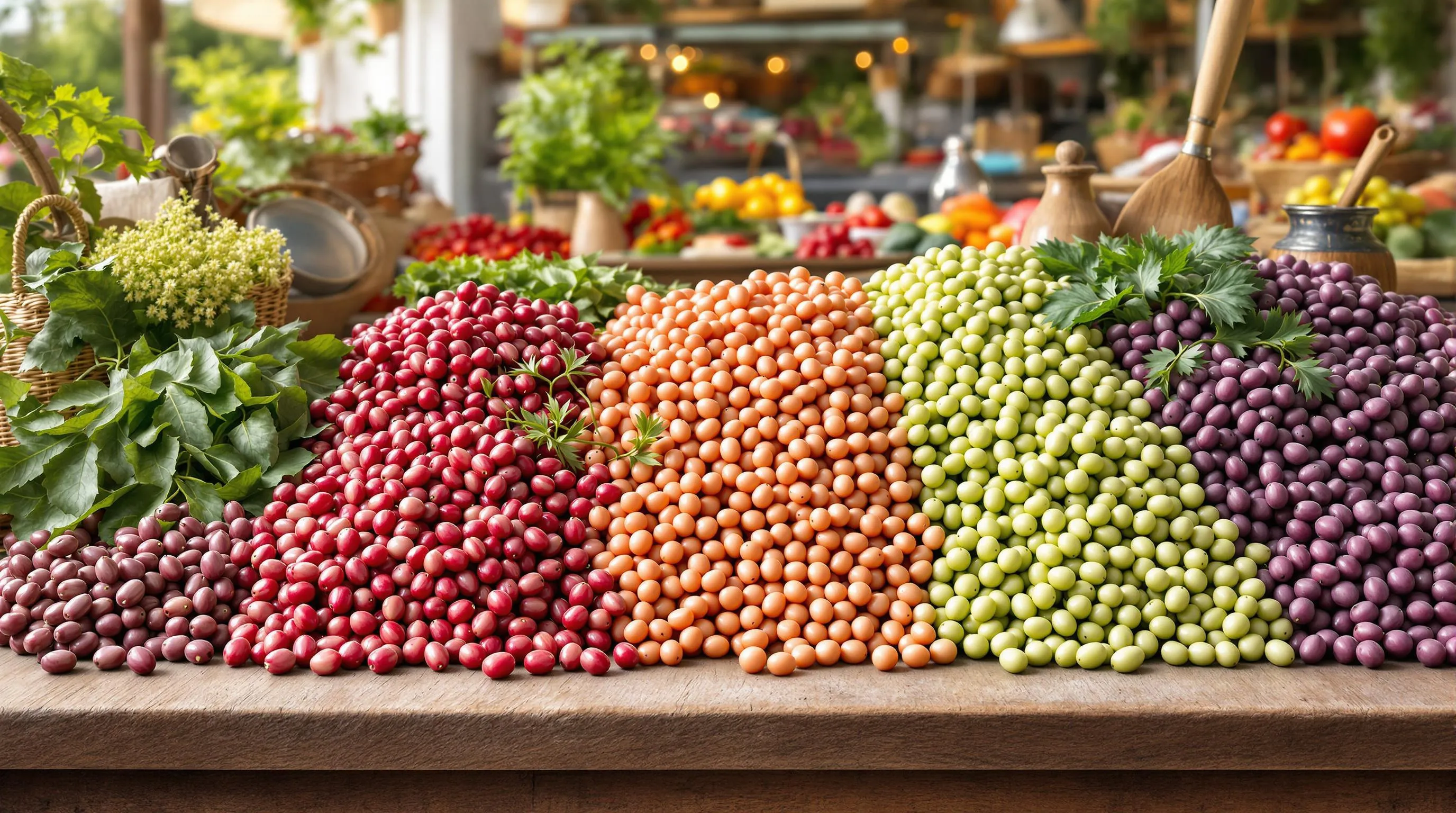
Shelled beans fall into two primary categories based on their harvest stage and preparation method. These versatile legumes offer distinct flavors textures and cooking applications depending on whether you choose fresh or dried varieties.
Fresh Shelled Beans
Fresh shelled beans represent the perfect middle ground in the bean lifecycle – harvested when the seeds inside the pods are fully developed but still tender and moist. These beans offer a creamy texture and sweet nutty flavor that dried beans simply cannot match. Popular varieties include flageolet cranberry (also known as borlotti) cannellini and flambo beans.
You’ll typically find fresh shelled beans at farmers markets and specialty grocers during late summer and early fall when they’re in season. Their superior texture makes them ideal for showcasing in dishes like minestrone pasta e fagioli and fresh bean salads. The cooking process for fresh beans is remarkably quick compared to their dried counterparts often taking just 20-30 minutes to become tender.
Many home cooks discover that fresh shelled beans require no pre-soaking which makes them perfect for spontaneous meal preparation. Their vibrant colors ranging from speckled cranberry beans to pale green flageolets add visual appeal to any dish they grace.
Dried Shelled Beans
Dried shelled beans are allowed to mature fully on the plant until the pods and beans inside become completely dehydrated. This natural drying process concentrates their flavors and significantly extends their shelf life making them an economical pantry staple. Common varieties include kidney beans pinto beans black beans and navy beans.
You can store dried beans for months or even years under proper conditions allowing for year-round access to nutritious protein-rich meals. Their versatility shines in hearty soups stews chilis and bean dips where they absorb surrounding flavors while maintaining their distinct characteristics.
Preparing dried beans requires advance planning as most varieties benefit from soaking for several hours or overnight before cooking. This preparation step not only reduces cooking time but can also make beans more digestible. The transformation of dried beans from hard pebble-like seeds to creamy tender legumes exemplifies cooking alchemy at its finest.
| Bean Type | Texture | Cooking Time | Best Uses |
|---|---|---|---|
| Fresh Shelled | Creamy yet firm | 20-30 minutes | Salads, light stews, side dishes |
| Dried Shelled | Dense, hearty | 1-2 hours (after soaking) | Soups, stews, dips, baked dishes |
Health Benefits of Shelled Beans
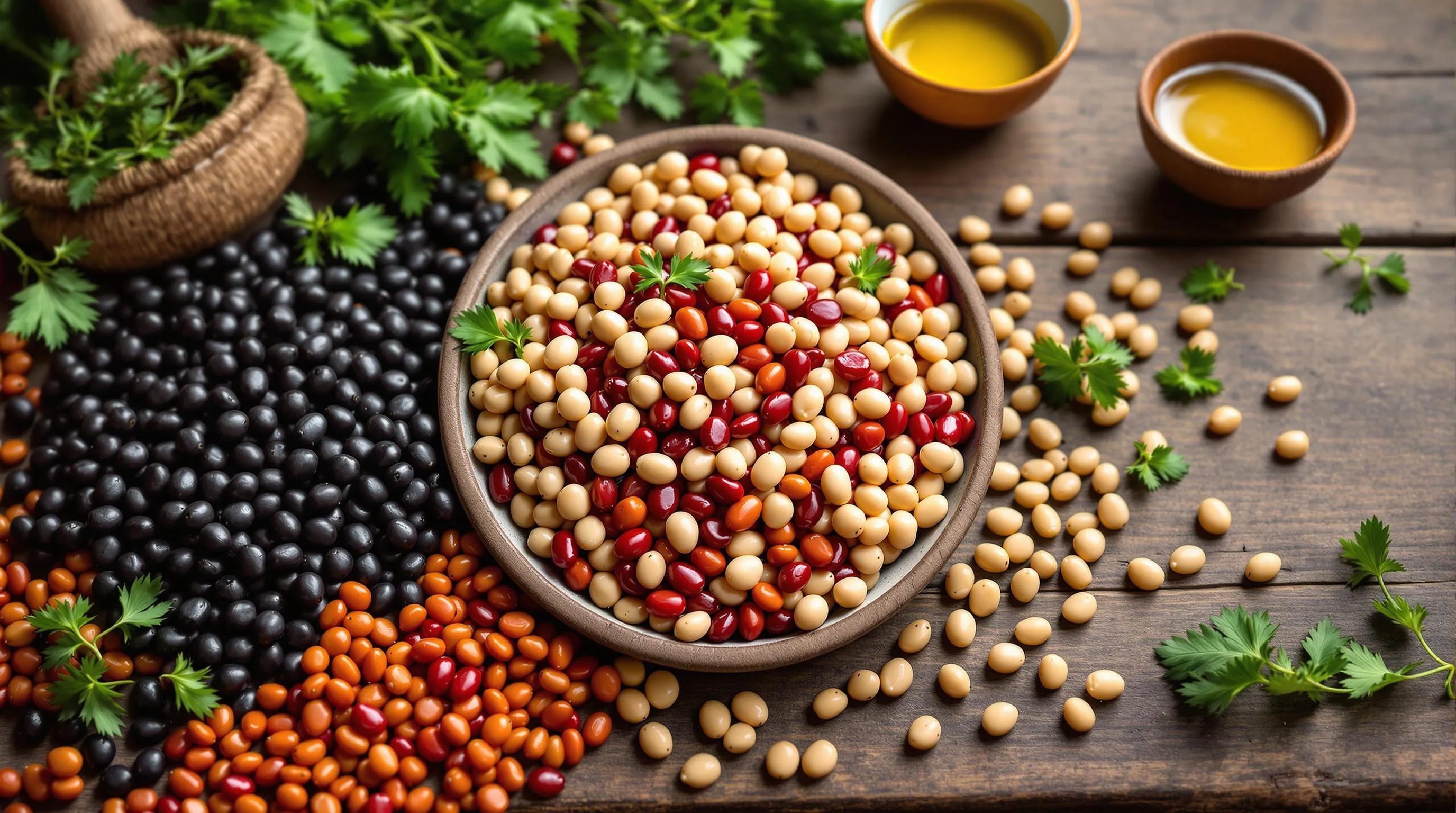
Beyond their versatility in the kitchen shelled beans offer an impressive array of health benefits that make them a nutritional powerhouse. These humble legumes pack a surprising punch when it comes to supporting your overall wellbeing.
Rich Nutrient Profile
Shelled beans serve as exceptional sources of essential nutrients your body needs to thrive. They contain:
- High-quality plant protein for muscle maintenance and repair
- Abundant dietary fiber for digestive health
- Folate crucial for cell division and DNA synthesis
- Iron to support oxygen transport in your bloodstream
- Potassium for healthy blood pressure regulation
- Magnesium essential for hundreds of biochemical reactions
- Powerful antioxidants including polyphenols that fight cellular damage
Heart Health Support
Your cardiovascular system receives important protection from regular bean consumption. Studies show that incorporating cooked shelled beans into your diet can lower LDL (bad) cholesterol by up to 19%. This impressive reduction translates to approximately 11% decreased risk of cardiovascular disease over time. The soluble fiber and polyunsaturated fats in beans work together to improve your cholesterol profile and maintain healthier blood pressure levels.
Blood Sugar Management
For those monitoring blood glucose levels shelled beans provide exceptional benefits. Their unique combination of complex carbohydrates soluble fiber and resistant starch helps slow carbohydrate absorption in your digestive tract. This leads to gentler blood sugar responses after meals making beans particularly valuable for people with diabetes or insulin resistance. Many of my readers with type 2 diabetes report more stable glucose readings after switching to bean-based meals several times weekly.
Weight Management Advantages
Looking to maintain a healthy weight? Shelled beans offer dual benefits through their protein and fiber content. These nutrients create lasting fullness that can help you consume fewer calories throughout the day. Research consistently shows that regular bean eaters tend to maintain lower body weights and smaller waistlines compared to those who rarely include legumes in their meals.
Digestive System Benefits
Your gut microbiome thrives when you consume shelled beans regularly. The combination of soluble and insoluble fiber serves multiple functions:
- Increases stool bulk for easier elimination
- Prevents constipation by promoting regular bowel movements
- Feeds beneficial gut bacteria that support immune function
- May reduce risk of colon cancer and other digestive diseases
Cancer-Fighting Properties
Shelled beans contain several compounds that may help protect against certain cancers. Their fiber content promotes colon health while saponins display anti-cancer properties in laboratory studies. The folate in beans supports proper DNA repair which further reduces cancer risk. Antioxidants present in these legumes help neutralize free radicals that could otherwise damage cells and potentially lead to cancerous growth.
Bone and Inflammation Support
The mineral content in shelled beans contributes to stronger bones throughout your life. Also many varieties contain compounds that help reduce inflammation throughout your body which may lower your risk of chronic inflammatory conditions.
| Health Benefit | Key Nutrients | Potential Impact |
|---|---|---|
| Heart Health | Soluble fiber, polyunsaturated fats | Up to 19% reduction in LDL cholesterol |
| Blood Sugar Control | Complex carbs, resistant starch | Improved glucose metabolism, steadier levels |
| Weight Management | Protein, fiber | Enhanced satiety, reduced calorie intake |
| Digestive Health | Soluble and insoluble fiber | Improved gut microbiome, regular bowel movements |
| Cancer Prevention | Fiber, saponins, folate, antioxidants | Reduced risk of colorectal cancer |
To maximize these health benefits try substituting shelled beans for processed meats and refined carbohydrates in your regular meal rotation. Your body will thank you for making this simple yet powerful dietary shift.
How to Shell Fresh Beans
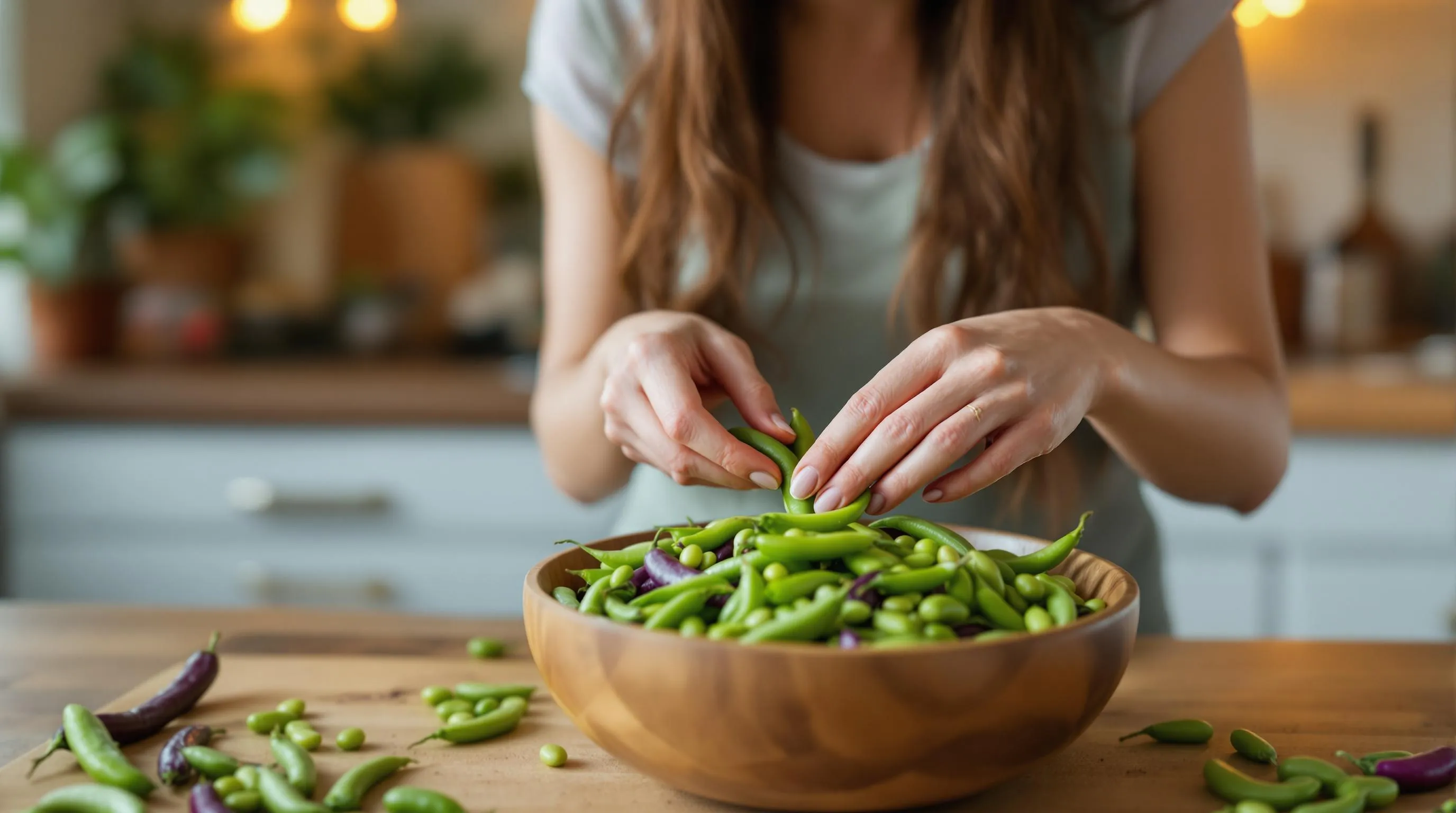
Shelling fresh beans might seem tedious at first but the process is quite straightforward and rewarding. Fresh beans should be shelled within one or two days of harvest to prevent spoilage and mold development. The effort pays off with beans that are sweeter creamier and more flavorful than their dried counterparts.
Start by breaking open the bean pod at the seam that runs along its length. Gently push your thumb inside and run it along the pod to release the beans into a bowl. The beans should pop out easily from mature pods. You’ll notice how the interior of the pod has a slightly silky texture that helps the beans slide out.
Always wash your freshly shelled beans under cool running water to remove any debris or pod fragments before cooking. This simple rinse ensures your beans are clean and ready for cooking or freezing. For maximum freshness shell your beans just before you plan to use them.
If you can’t cook your beans immediately after shelling don’t worry. Freshly shelled beans freeze exceptionally well and maintain their quality for up to six months when properly stored. Place them in airtight containers or freezer bags removing as much air as possible before sealing.
Many home cooks find the process of shelling beans meditative. The repetitive motion creates a rhythm that can be quite calming especially when done while chatting with family or listening to music. The sensory experience of feeling the beans pop from their pods connects you to your food in a way that opening a can simply cannot replicate.
The yield from shelling fresh beans might surprise you. A pound of fresh bean pods typically produces about one cup of shelled beans. This conversion is helpful to keep in mind when planning recipes that call for exact amounts of shelled beans.
Remember that different varieties of beans may have slightly different shelling techniques. Fava beans for instance require an additional step of removing the waxy coating around each individual bean after shelling. Lima beans on the other hand shell similarly to other varieties but their pods can be tougher requiring a bit more force to open.
By taking the time to shell beans yourself you’ll gain appreciation for their natural beauty. The vibrant colors and patterns of freshly shelled cranberry beans or the creamy texture of newly shelled lima beans offer a sensory experience that processed foods simply cannot match.
Ingredients for Basic Shelled Beans
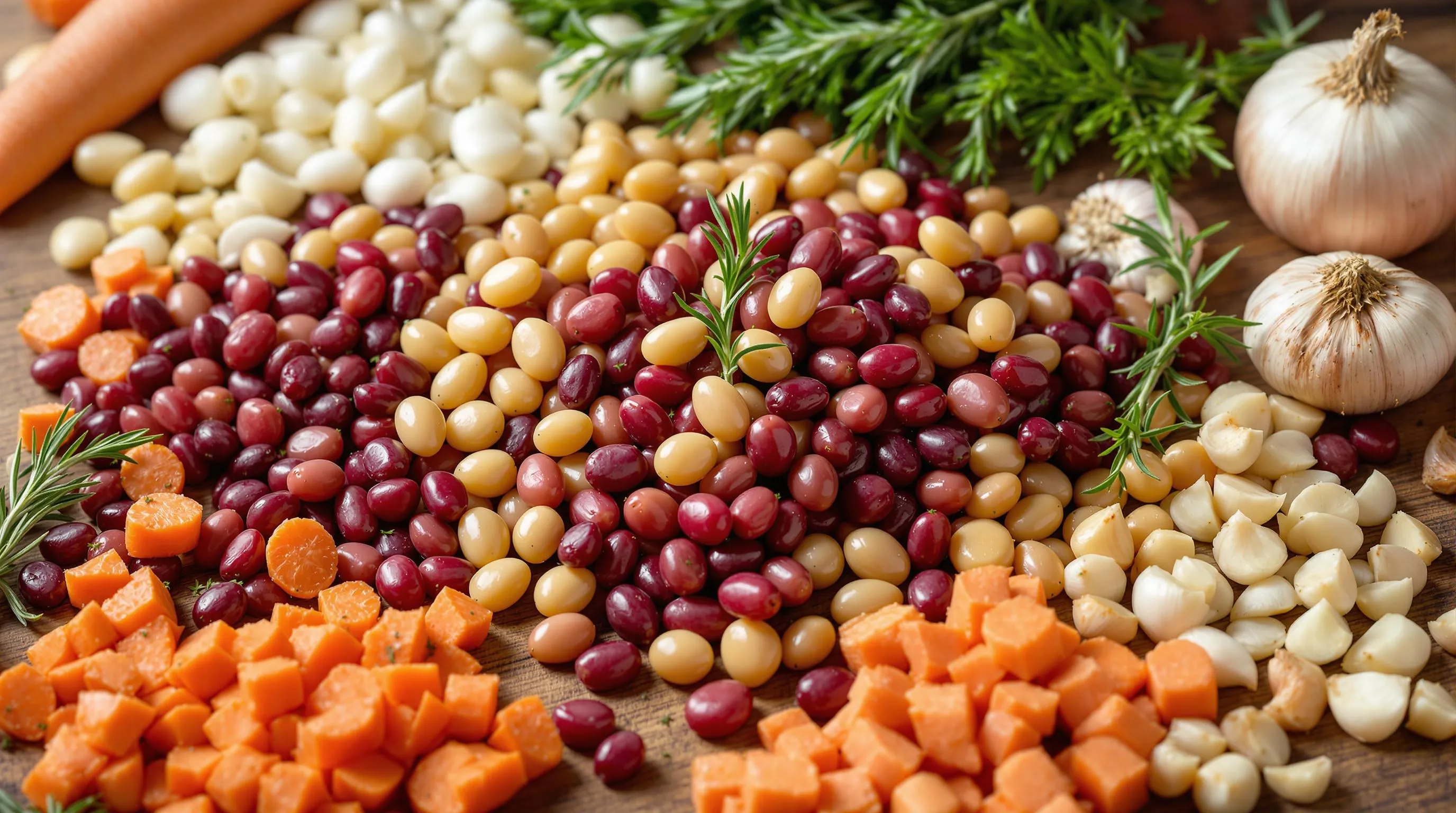
Creating a delicious pot of shelled beans requires just a handful of quality ingredients that work together to enhance their natural flavors. These simple components transform humble beans into a satisfying dish that can serve as either a hearty side or a nourishing main course.
Fresh Beans
- 2-3 cups fresh shelled beans (approximately 1-2 pounds before shelling)
- Popular varieties: cranberry beans, borlotti beans, or “tongues of fire” beans
Aromatics and Vegetables
- 1 cup finely diced onion (or ½ cup for a milder flavor)
- 2-5 cloves garlic minced
- ½ cup diced carrots
- ½ cup diced celery
- Optional: ½ cup diced bell pepper for color and sweetness
Herbs and Seasonings
- 2-3 sprigs fresh rosemary thyme or sage
- Small bunch of fresh parsley chopped
- 1-2 bay leaves
- Sea salt and freshly ground black pepper to taste
Liquids and Enrichments
- 3-4 tablespoons extra virgin olive oil
- 8 cups chicken broth or vegetable stock (amount may vary based on cooking method)
- Optional: Parmesan cheese rind for added richness
- Optional: 1-2 tablespoons finishing olive oil for drizzling
Optional Flavor Enhancers
- Prosciutto bone or ham hock for smoky depth
- Small pasta like ditalini or orzo for a heartier dish
- Freshly grated Parmesan cheese for serving
- Red pepper flakes for heat
The beauty of shelled beans lies in their versatility. You can adjust these ingredients based on what’s available in your pantry or garden. Fresh beans require no pre-soaking and cook much faster than their dried counterparts making them perfect for weeknight meals that taste like they’ve been simmering all day.
Directions
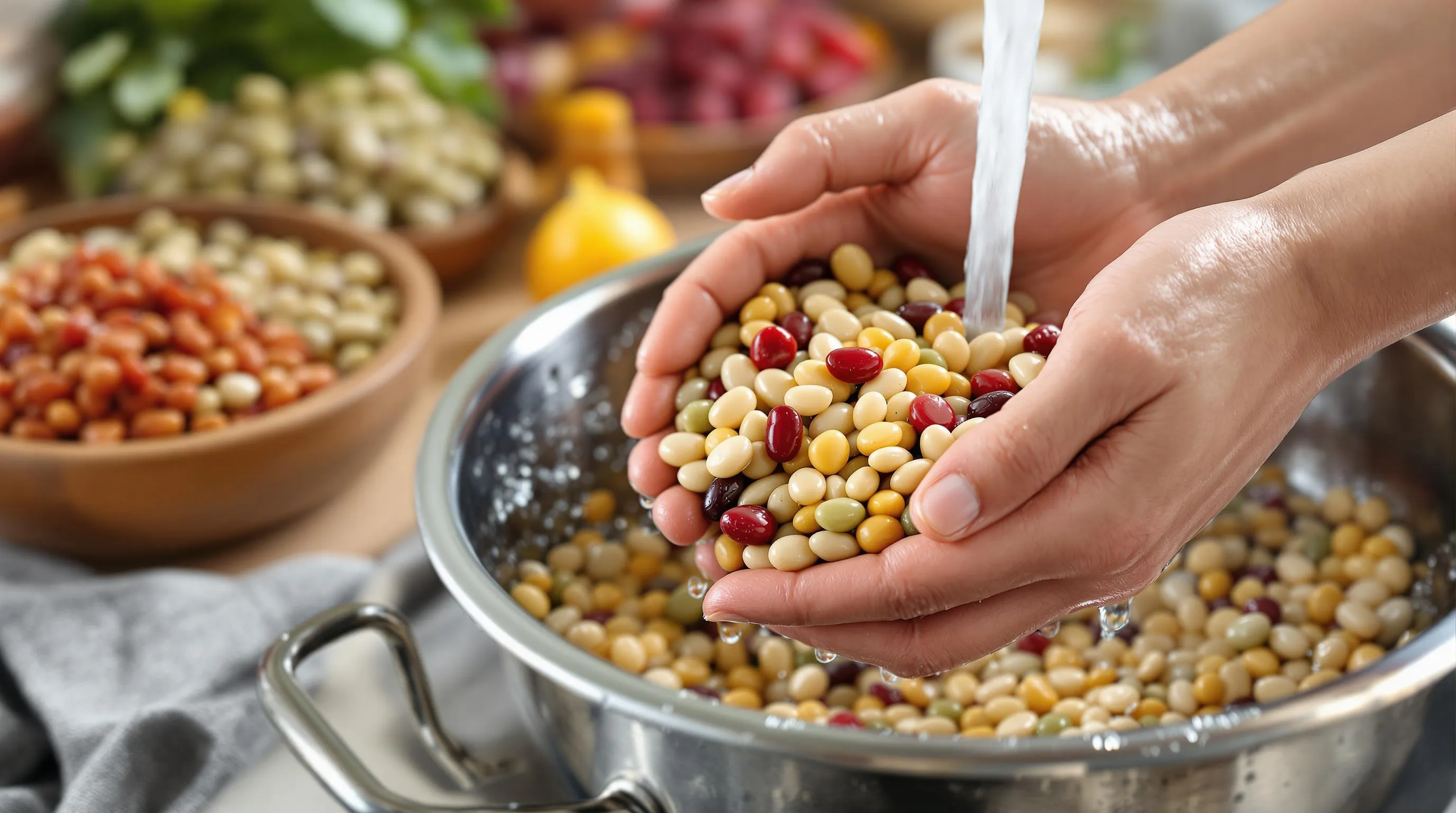
Follow these simple steps to transform your fresh shelled beans into a delicious dish with perfect texture and flavor. The cooking process is straightforward but requires attention to detail for the best results.
Preparing Fresh Shelled Beans
Start by removing beans from their pods if you purchased them unshelled. Rinse your freshly shelled beans thoroughly under cold water to remove any debris or pod remnants. Fresh “shellies” such as lima, butter, cranberry, and pinto beans need minimal preparation compared to their dried counterparts. These young tender beans cook significantly faster than dried varieties, so timing is crucial to preserve their fresh texture and flavor. Sort through the beans quickly to remove any damaged ones before cooking to ensure the best eating experience.
Cooking Method
Choose the cooking technique that best suits your schedule and desired outcome. For traditional simmering, place your shelled beans in a pot with enough cold water to cover them by approximately 2 inches. Bring to a gentle simmer and cook for 30-45 minutes until the beans are tender but still maintain their shape. Steaming offers a gentler alternative that helps preserve the beans’ delicate flavor and texture. For a quicker option, use an Instant Pot or pressure cooker—first sauté aromatics like onions and garlic, add your beans with stock, then cook under high pressure for 2-3 minutes until tender. You can also create more complex dishes by initially cooking the beans, then combining them with sautéed aromatics and greens before braising with tomatoes and broth. Avoid vigorous boiling during any cooking method as this can cause bean skins to burst and create a mushy texture.
Seasoning Your Beans
Enhance the natural flavor of your shelled beans with thoughtful seasoning choices. Add salt either during cooking or just before serving, depending on your preference for seasoning absorption. Incorporate aromatics such as garlic, onions, bay leaf, sage, or rosemary during the cooking process to infuse the beans with depth. Drizzle high-quality olive oil both during cooking and as a finishing touch to add richness and mouthfeel. Fresh herbs like parsley or thyme brighten the dish when added just before serving. Balance the earthiness of beans with acidic components such as red wine vinegar or tomatoes for dimension and brightness. Experiment with warming spices like black pepper, chili flakes, or cumin to create more complex flavor profiles. Once cooked, your beans can be transformed into vibrant salads with olive oil and vinegar dressings or hearty warm dishes combined with garlic, seasonal greens, and tomatoes.
Simple Shelled Bean Recipes
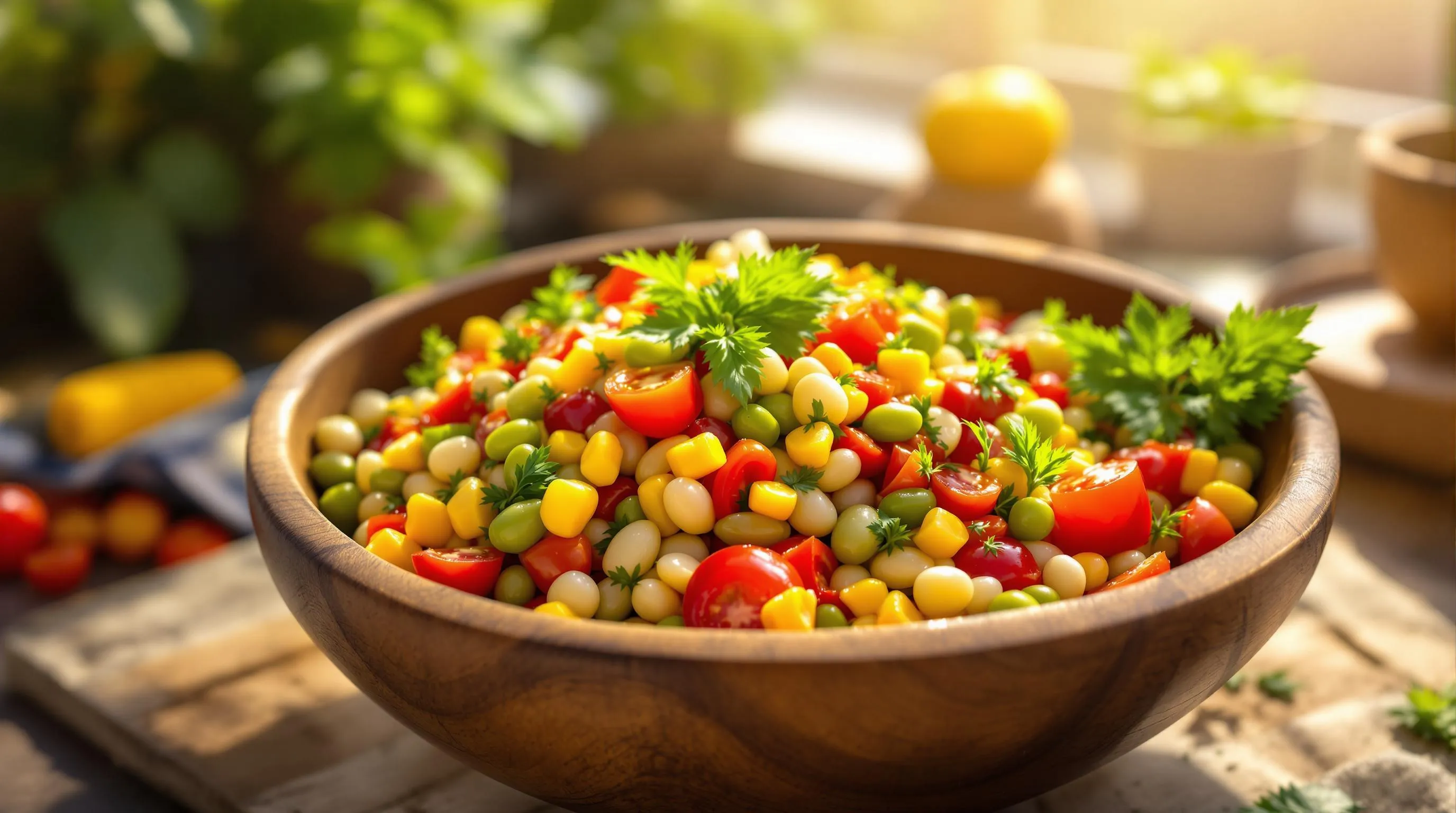
Fresh shelled beans shine in straightforward recipes that highlight their natural flavors and creamy texture. These versatile legumes transform into delicious dishes with just a few complementary ingredients.
Shell Bean Salad
This warm salad showcases the delicate flavor of freshly shelled beans. Cook your beans until tender then toss them while still warm with shredded radicchio for a pleasant bitter contrast. Add fresh parsley minced garlic salt olive oil and red wine vinegar to create a balanced dressing. Finish with freshly ground black pepper for a subtle heat that enhances the beans’ natural sweetness. This simple preparation serves 4-6 people and makes an excellent side dish or light meal when paired with crusty bread.
Shell Bean Gratin
Transform humble shelled beans into a comforting gratin with this foolproof method. Start by cooking your beans with fragrant sage olive oil and salt until they reach the perfect tenderness. In a separate pan sauté onion and garlic until translucent then add your favorite leafy greens. Combine these aromatics with ripe tomatoes and the cooked beans in a baking dish. Top everything with golden toasted breadcrumbs for a satisfying crunch. This rustic dish embodies farmhouse cooking with minimal ingredients allowing the beans to take center stage.
Tuscan-Style Shelled Beans
White cannellini beans form the foundation of this classic Tuscan-inspired salad that celebrates simplicity and fresh ingredients. Mix your shelled beans with diced red onion minced garlic fresh thyme and a pinch of red pepper flakes for gentle heat. Season with sea salt and brighten with lemon juice. Briny capers add depth while colorful bell peppers contribute sweetness and crunch. Fresh parsley and dill provide herbal notes that elevate the entire dish. This nutritionally complete salad comes together in about 15 minutes making it perfect for busy weeknights. The recipe accommodates various dietary needs as it’s naturally vegan and gluten-free.
Creamy Shelled Bean Soup
This luxurious soup develops remarkable depth of flavor through careful simmering of shelled beans with aromatic vegetables. Combine your beans with diced carrots celery onions and herbs such as thyme bay leaves and parsley. Add peppercorns and parmigiano rinds to infuse the broth with savory richness as the beans cook to creamy perfection. Finish the soup with a generous pat of butter for silkiness and brighten with fresh lemon zest. Season thoughtfully with salt and black pepper to enhance the natural flavors. The resulting soup offers comfort in every spoonful with beans that maintain their integrity while becoming irresistibly creamy.
Summer Bean Salad
Celebrate summer’s bounty by pairing fresh shelled beans with peak-season vegetables in this vibrant salad. Combine your tender beans with diced onion minced garlic colorful bell peppers tart tomatillos and juicy tomatoes. Sweet corn kernels add pops of sweetness and texture throughout the dish. For those who enjoy heat incorporate diced hot chiles to taste. Toast and grind cumin seeds to release their earthy aroma before adding to the salad. Cook everything briefly with a splash of vegetable stock to marry the flavors while maintaining the vegetables’ fresh character. Finish with generous handfuls of fresh herbs like parsley or cilantro that contribute brightness and color. This versatile dish works as a side or main course showcasing the bean’s ability to complement summer’s most flavorful produce.
How to Store Shelled Beans

Proper storage is crucial to maintaining the flavor, texture and nutritional value of your shelled beans. Different storage methods apply depending on whether your beans are fresh or cooked.
Fresh Beans
Fresh shelled beans require prompt attention to preserve their sweet creamy texture. Store them in the refrigerator for up to two days in an airtight container if you plan to use them quickly. For longer preservation freezing is your best option – fresh beans should be shelled within one to two days after harvest to prevent mold development. Simply place the uncooked shelled beans in freezer-safe containers without any additional preparation. Your frozen fresh beans will maintain their quality for up to six months making them a convenient addition to winter soups and stews.
When working with fresh beans from the farmers market I always make a point to process them promptly. The difference in flavor between properly stored beans and those left too long in their pods is remarkable – freshly shelled beans offer that distinctive sweet earthiness that makes dishes truly special.
| Bean State | Storage Method | Duration | Notes |
|---|---|---|---|
| Fresh Shelled | Refrigerate | 1-2 days | Use soon to prevent spoilage |
| Fresh Shelled | Freeze uncooked | Up to 6 months | Shell promptly after purchase |
Cooked Beans
Cooked shelled beans offer even more storage flexibility. After cooking your beans allow them to cool completely before transferring to airtight containers for refrigeration. They will keep well for several days making meal prep convenient and efficient. Freezing cooked beans extends their shelf life significantly – portion them into meal-sized containers before freezing for easy addition to soups salads and stews later.
The cooking liquid from your beans contains valuable flavor and nutrients so consider storing the beans in this liquid rather than draining them completely. Properly stored cooked beans maintain their integrity without becoming mushy making them perfect for quick weeknight meals.
For longer term storage fully dried beans offer exceptional shelf stability. Store dried beans in airtight containers in a cool dry place where they will remain viable for months. Some home cooks even pressure can their cooked beans extending storage up to a year when kept in a cool dark place.
| Bean State | Storage Method | Duration | Notes |
|---|---|---|---|
| Cooked Shelled | Refrigerate | Few days | Store cooled in their cooking liquid |
| Cooked Shelled | Freeze | Several months | Excellent for meal preparation |
| Dried Shelled | Airtight container | Several months to 1 year | Keep in cool dry location |
Tips for Perfect Shelled Beans Every Time

Selecting Beans
Choosing the right beans makes all the difference in your final dish. Look for beans based on their maturity level – young beans typically have tight and slightly green pods while mature beans come in brown shriveled pods. Keep these two types separate during the shelling process since they require different cooking times. Mature beans need longer cooking so add them to your pot first then introduce younger beans later for perfectly even cooking results.
Shelling
Removing beans from their pods is straightforward and surprisingly satisfying. The simple process involves opening the pod along its seam and scooping out the tender beans inside. This task can become a wonderful family activity that even young children can participate in. Many home cooks find the repetitive nature of shelling beans to be almost meditative – a chance to slow down and connect with your food before cooking begins.
Storage
Fresh shelled beans maintain their quality in the refrigerator for a couple of days at most. For longer preservation options you have two excellent choices. Cook your beans completely then freeze them in airtight containers with some of their cooking liquid. Alternatively spread raw shelled beans in a single layer on a baking sheet and freeze them solid before transferring to freezer bags for storage up to six months. This method preserves their fresh texture remarkably well.
Cooking
Always rinse your shelled beans thoroughly before cooking to remove any debris. Use just enough water to cover the beans by approximately one inch in your cooking pot. Enhance the cooking liquid with aromatic additions like bay leaves and garlic cloves but remember to add salt only after cooking is complete to avoid toughening the beans. Simmer gently until beans reach your desired tenderness – young beans might need just 15-20 minutes while mature beans could require 30 minutes or more.
For a time-saving alternative try your pressure cooker or Instant Pot. Begin by sautéing aromatics like onions and celery then add your beans and stock. Cook under high pressure for 2-5 minutes depending on your preferred tenderness level. The key to perfectly cooked beans lies in testing them frequently during cooking to catch them at just the right moment before they become mushy.
Serving Suggestions
Transform your perfectly cooked shelled beans into satisfying meals with simple finishing touches. Create vibrant bean salads by tossing warm beans with good olive oil fruity vinegar freshly ground pepper and handfuls of chopped herbs. Elevate your beans into a hearty gratin by combining them with sautéed greens diced tomatoes and crispy toasted breadcrumbs then baking until golden and bubbling. Add depth to soups by incorporating beans with Italian bacon or pancetta along with seasonal vegetables for a complete meal in a bowl.
Conclusion
Shelled beans stand as unsung heroes in the culinary industry offering exceptional nutrition value versatility and affordability. Whether you choose fresh varieties with their creamy texture and quick cooking time or opt for dried beans as pantry staples you’ll enjoy a wealth of health benefits from heart support to improved digestion.
The simple joy of shelling beans connects you directly to your food while creating dishes that range from vibrant summer salads to comforting winter soups. With proper storage techniques and a few cooking tips you can transform these humble legumes into extraordinary meals.
Embrace shelled beans as a delicious sustainable protein source that adapts to countless cuisines and cooking methods. Your body your budget and your taste buds will thank you.
